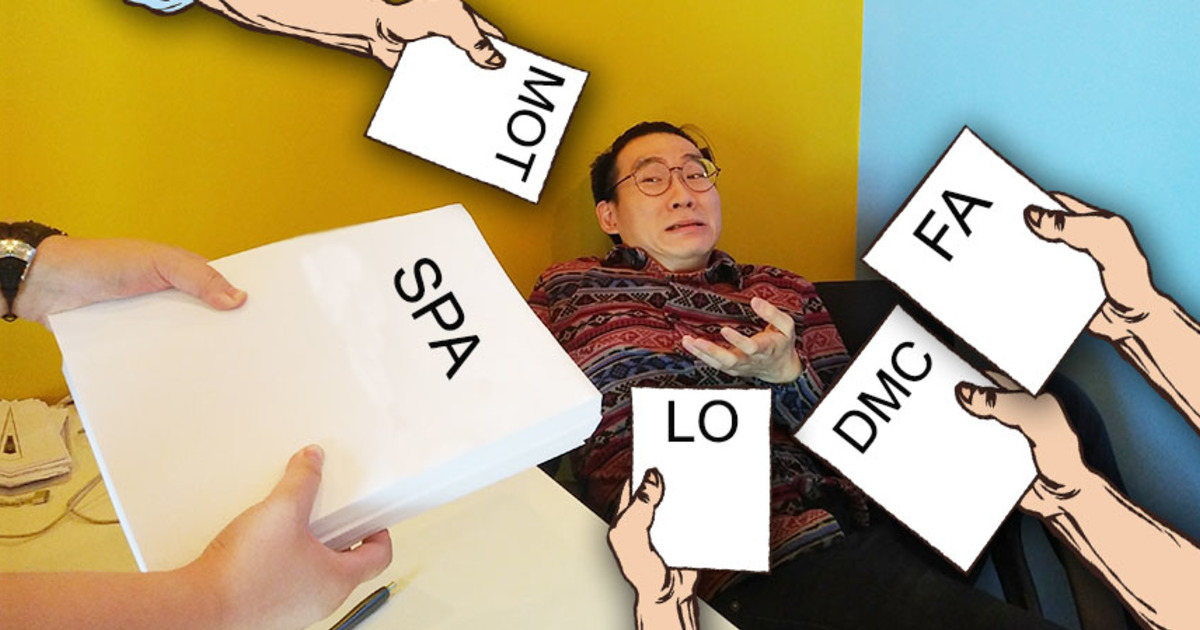

Consumer,Property
Have you ever bought a house in Malaysia and had no idea what you signed?
over 7 years ago Denise C.It starts off this way – an amazing fairy tale, you grow up, trundle through life, and decide that it is time for you to plant your roots down and buy a house. Maybe you decide to do this on your own or, perhaps, you just got married and are looking for that special home to raise your lil tater tots in.
Regardless of your drive to buy a house, you would all go through (more or less) the same process. You stride into a developer’s office/ respond to an ad, view the house, fall in love with it, gush over it, and decide to buy it. You know that buying a house would definitely come with some paperwork to be settled. So, you roll your sleeves up and get to work signing. However, the paperwork never seems to end...you try to read the thick piles of documents handed over to you, ask questions but only receive answers which continue to puzzle you.
At one point, you feel your internal self screaming and you give up on questions and just furiously sign everything away. It’s done, it’s over but...what have you done? Now, usually when you buy a house, you would also apply for a bank loan. This article will deal with both sets of documents so let’s start off with the sales part first.

Image from giphy.com
PROTIP: If you’re reading this with a bunch of house buying-related documents staring at you, you may want to use CTRL+F to find what you’re looking for instead of scrolling back and forth.
Developer’s Letter of Offer (LO)
You would most likely be besieged by a whole bunch of documents once you turn to the salesperson and indicate your willingness to buy one of their houses. The first document that you would sign, whether or not it is a purchase from a developer or a sub-sale (basically from a previous home owner), would generally be a letter of offer.
To be more accurate, the developer would give you a letter of offer, indicating their willingness to sell you the house and you will sign it to signify your acceptance. In sub-sale cases, this may manifest through a simple form provided by the property agent or sometimes, there is no letter of offer at all.
Sale and Purchase Agreement (SPA)
Then, the next stage is usually the signing of the sale and purchase agreement. This is usually done in the presence of a lawyer, who will explain the core terms of the contract to you. If you are engaged in a sub-sale, your lawyers will usually hash out the terms of your agreements until both you and the seller agree to the final contract. However, in developer cases, their sale and purchase agreements usually follow the ones set out in the Housing Development (Control and Licensing) Act 1966 and the Housing Development (Control and Licensing) Amendment Regulations 2015.
Regardless of which kind of agreement it is, there are several important clauses that you need to take note of/ask your lawyer about. In a quick list, they are:
Check the title
Your agreement should list down the details of the title to the house. The title is one of the most important parts of the agreement because the title tells you if the seller is the actual owner of the property and whether it is currently charged (simple explanation – a house is charged when it is used for security for loans) to any other bank. In an extrapolation from this, the agreement should also contain a clause that the seller promises to deliver the title to you, in other words, he promises that he will transfer the ownership in the title from his name to your name upon completion of the agreement.
Free from encumbrances

This means that there must be a clause to clarify that the property will be delivered to you free from any other claims. For example, if the property is currently charged, the seller must promise to clear the charge before the property is delivered to you.
Vacant possession
This is when you would get the keys to your house. The date is not the only important consideration here, also find out the manner in which vacant possession would be delivered. Common conditions for vacant possession include the house coming with a certificate of completion and compliance (certifying that the house is safe to live in. Read more here.) and water and electricity connection.
Defect liability period
This is basically a warranty for your house where during that time, the developer would be responsible for defects arising in the house. In contrast, sub-sale homes are typically sold on an as-is basis, meaning you get what you get.
Late payment charges/liquidated damages
The first relates to the any late payment interest that you would be liable to if you fail to pay the developer/seller in the stipulated time. The second relates to if the developer/seller fails to deliver vacant possession at the agreed time and he has to pay you damages.
Area of your house
This sounds like a dumb thing to take note of but it is important to take note of especially in developer sales. This is because the measurements that you would see in your agreement’s schedule is subject to final measurement and should there be any significant reduction in size, an adjustment sum can be paid by the developer.
House plans
This can be found in the First Schedule for developer sales and is basically shows you the layout of your house and the designs.
Payment schedule
This is typically found in the Third Schedule for developer sales and it tells you when you have to pay and how much. If you have a 90% loan, you won’t have to worry too much about this part because the bank and their lawyers will be responsible to arrange the payments but information is always good to have.
Deed of Mutual Covenants (DMC)

This is usually only found for strata properties where the deed of mutual covenants acts as a set of rules/promises that all the homeowners in that property make to each other. It is signed alongside the sale and purchase agreement and can cover things like how many pets you are allowed to have, what kind of renovations you can carry out in your property and so on. If you are wondering what’s the use of it, it’s basically to create those perfect little suburban communities that you see on TV.
Memorandum of Transfer (MOT)
A memorandum of transfer is used to transfer the ownership in the house from the developer/seller to you. For developer cases, it may or may not happen at the time you purchase the house because houses which are still under construction may not have their titles issued yet. However, it is not cause for worry because when the title is issued, the developer will contact you to sign the memorandum of transfer.
Bank’s Letter of Offer (LO)
The bank’s letter of offer is similar to the developer’s letter of offer and it’s issued when the bank’s approves your loan application and offers you a certain sum, at a certain interest rate, to be repaid within a certain number of years.
Facilities Agreement (FA)
A facilities agreement is the main loan agreement and it doesn’t relate to the facilities you will receive at your new home. It basically refers to the money that the bank will loan to you.
Generally, the bulk of its terms do not vary between borrower to borrower. What is different for your case, or what terms apply for your loan will generally be found in the letter of offer. This letter of offer will then be attached to the facilities agreement.
Deed of Assignment (DOA)

The deed of assignment is basically a document that assigns your rights and interests in the property over to your financier for the duration of the loan. This is where the every day understanding of security in return for money comes from. The money aspect is found predominantly in the facilities agreement while the security aspect is in the deed of assignment.
An important point to note is that if there is one borrower but two purchasers, both the purchasers will still have to sign the deed of assignment and power of attorney (we will come to this in a bit). We know this sounds confusing because if you are the borrower, why does your wife/husband/sibling/co-owner have to sign bank documents as well? Does this make them liable to the bank too?
This is the logic behind it – because the property is being used as security, all the owners to the property must consent to the house being used as security and, subsequently, they must also agree to transfer their rights and interests under the property to bank as well. This is known as a third party loan. Where the purchasers are the same people as the borrowers, it is called a first party loan. To illustrate this, let’s look at some examples.
Ali and Siti buy a home under both their names.
Ali and Siti both apply for a bank loan under their names.
Both of them must sign all the sale and purchase documents and the loan documents.
This is a first party loan.
Ah Chong and Ah Mei buy a home under both their names.
Ah Chong applies for a bank loan under his name alone.
Ah Chong and Ah Mei must both sign the sale and purchase documents and part of the loan agreement.
Ah Chong signs the facilities agreement on his own because he is the sole borrower.
This is a third party loan.
Power of Attorney (PA)
A power of attorney is essentially a document that allows the bank to deal with your property on your behalf. This is to facilitate the bank having security in return for the loan they borrow to you. Similar to the deed of assignment, all purchasers must sign this document.
Memorandum of Charge (MOC)

Image from popkey.co
Remember the memorandum of transfer that we talked about earlier? We mentioned that whether or not a memorandum of transfer is signed at the point of purchase depends on whether the title to the property has been issued. Similarly, whether or not a memorandum of charge is signed at the point of purchase depends on whether the title to the property has been issued.
If a title has been issued, then you will sign a memorandum of charge in lieu of the deed of assignment and power of attorney.
In essence, the MOC has the same purpose as the DOA and PA wherein it’s an instrument wherein you provide security to the bank with. The MOC is where your charge the property over to the bank in return for the money they will give you.
If you have made it this far, rejoice because all the major documents involved in a land sales have been dealt with. However, there are still some tiny details here and there which we will deal with after we explain what documents you have to sign with and without the title.
With title
With the title, you will sign both the letters of offer, SPA, DMC, MOT, FA, and MOC.
Without title
Without the title, you will sign both letters of offer, SPA, DMC, FA, DOA, and PA. The MOT and MOC will be signed at a later period when the title has been issued.
Statutory Declarations
You would possibly sign a few statutory declarations in the course of buying and getting a loan for your house. Statutory declarations are basically declarations you make officially and in a way, carry more oomph than a normal declaration. Common declarations in this transaction will be declarations that you are not bankrupt or declarations that you would use the property for your own occupation.
Stamp duty
This is not a document you have to sign but it is a what you have to pay when you stamp your documents. If you are utterly confused, stamping a document is not the stamp you affix on a letter to send it out.
Stamping is basically a process you do to make sure that if you ever go to court, your documents can be admitted as evidence in court. The amount you have to pay for stamp duties varies with the documents. For example, the nominal fee is usually paid for statutory declarations while the stamp duty for the facilities agreement depends on your loan sum.
There is also stamp duty to be paid upon signing the MOT, which would depend on the value of your house.
Well, that’s it. All the documents (or information) that are listed above are basically the essential things you need to know as someone who is buying property in Malaysia. If you have any further questions, don’t forget to direct them to your lawyer as they are there to help explain things to you guys and also highlight any special clauses or terms in your contract.
If you want to impress your friends by being able to efficiently read any form of contract, check out our guide below
[READ MORE: How to not fall off your chair when given a 50-page contract]

"No no I clean"